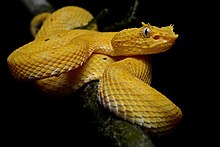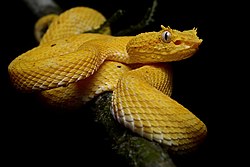Eyelash viper
The eyelash viper (Bothriechis schlegelii) is a venomous pit viper found in Central and South America.
| Eyelash viper | |
|---|---|

| |
| Scientific classification | |
| Kingdom: | |
| Phylum: | |
| Subphylum: | |
| Class: | |
| Order: | |
| Suborder: | |
| Family: | |
| Subfamily: | |
| Genus: | |
| Species: | B. schlegelii
|

Small and living in trees, the snakes has a lot of color variations. Note the superciliary scales above the eyes.
It is the most common of the green palm-pitvipers (genus Bothriechis).[1]
Description change
The eyelash viper is a small species of snake, and rarely ever grows longer than the length of 75 centimetres (2.5 feet). Females are larger than males. It gets the name "eyelash viper" because it has a small group of scales over its eyes which make it look like the snake has eyelashes. The eyelash viper comes in many colors like green, yellow, red, brown or even pink.
Behavior change
Like other snakes of the genus Bothriechis, this species is arboreal, meaning it lives in trees. The eyelash viper is nocturnal. It is not known to be aggressive, but if annoyed or disturbed it doesn't hesitate to strike. The viper is viviparous, meaning it gives live birth. It gives birth to around 10 to 12 young at a time. When they are born, young vipers are 13–23 centimetres (5–9 inches) inches long.
Feeding change
Eyelash vipers capture their prey by ambushing. They feed on small rodents, small birds, frogs, and lizards.
Common names change
The eyelash viper is also known as the 'eyelash mountain viper", the "horned palm viper", Schlegel's viper", and the "eyelash palm-pit viper". It is also known as the "bocaracá" in Costa Rica and other Central and South American countries.
Where they live change
The eyelash viper is found in southern Mexico, southeastward to the Atlantic lowlands, through Central America to northern South America in Colombia and Venezuela. It is also found in parts of Costa Rica, Panama, Ecuador, and Peru.
Habitat change
The viper likes to live in humid, tropical areas not far from water.
References change
- ↑ Lewis, Robert Alan 1998. Lewis' Dictionary of Toxicology. CRC Press, p187. ISBN 978-1-56670-223-2